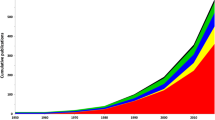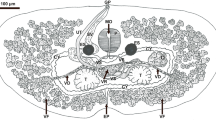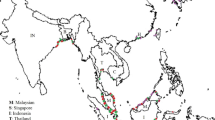Abstract
The ornamental fish trade provides a pathway for the global translocation of aquatic parasites. We examined a total of 1020 fish imported from Singapore, Malaysia, Thailand, or Sri Lanka to Australia (including freshwater and marine fish species) for monogenean ectoparasites. Fish were received following veterinary certification that they showed no clinical signs of pests and diseases from the exporting country and visual inspection at Australian border control. Australian import conditions require mandatory treatment for goldfish with parasiticides (e.g. trichlorfon, formaldehyde, sodium chloride) for the presence of gill flukes (Dactylogyrus vastator Nybelin, 1924 and Dactylogyrus extensus Mueller and Van Cleave, 1932) prior to export. Over 950 individual parasites were detected in five imported fish species, representing 14 monogenean species. Seven Dactylogyrus spp. including D. vastator and three Gyrodactylus spp. infected goldfish, Carassius auratus Linnaeus, 1758, from Malaysia, Singapore, and Thailand. Dactylogyrus ostraviensis Řehulka, 1988, infected rosy barb, Pethia conchonius Hamilton, 1822, from Singapore, Sri Lanka, and Thailand while two Trianchoratus spp. infected three spot gourami, Trichopodus trichopterus Pallas, 1970 and pearl gourami Trichopodus leerii Bleeker, 1852, from Sri Lanka. Urocleidoides reticulatus Mizelle & Price, 1964, infected guppy, Poecilia reticulata Peters, 1859, from Sri Lanka. The discovery of D. vastator in goldfish, as well as 13 other monogenean species, shows that pre-export health requirements, which include chemical treatment of goldfish, and inspection of all ornamental fish species did not prevent infection by monogeneans. Inspection prior to exportation and at border control must account for the highly cryptic nature of monogenean parasites and consider alternatives to current pre-export conditions and visual inspection at border control.







Similar content being viewed by others
Change history
27 November 2018
The phylogenetic tree (Figure 7) in the published document has incorrect Bayesian analysis posterior probabilities. This error prevents accurate analysis by future research in parasitology. The figure is therefore replaced by the corrected figure below.
27 November 2018
The phylogenetic tree (Figure 7) in the published document has incorrect Bayesian analysis posterior probabilities. This error prevents accurate analysis by future research in parasitology. The figure is therefore replaced by the corrected figure below.
References
Australian Bureau of Agricultural and Resource Economics and Sciences (ABARES), 2016. In: Australian Department of Agriculture and Water Resources. www.agriculture.gov.au/abares. Accessed 14 January 2017
Balon EK (2004) About the oldest domesticates among fishes. J Fish Biol 65(s1):1–27. https://doi.org/10.1111/j.0022-1112.2004.00563.x
Biosecurity Import Conditions System (BICON) (2017) In: Australian Department of Agriculture and Water Resources. www.agriculture.gov.au/import/online-services/bicon. Accessed 13 June 2017
Becker JA, Tweedie A, Rimmer A, Landos M, Lintermans M, Whittington RJ (2014) Incursions of cyprinid herpesvirus 2 in goldfish populations in Australia despite quarantine practices. Aquacult 432:53–59. https://doi.org/10.1016/j.aquaculture.2014.04.020
Cobo F, Vieira-Lanero R, Rego E, Servia MJ (2010) Temporal trends in non-indigenous freshwater species records during the 20th century: a case study in Iberian Peninsula. Biodivers Conserv 19(12):3471–3487. https://doi.org/10.1007/s10531-010-9908-8
Cohen J, Mirotchnick N, Leung B (2007) Thousands introduced annually: the aquarium pathway for non-indigenous plants to the St Lawrence Seaway. Front Ecol Environ 5:528–532
Corfield J, Diggles B, Jubb C, McDowall RM, Moore A, Richards A, Rowe DK (2007) Review of the impacts of introduced aquarium fish species that have established wild populations in Australia. Prepared for the Australian Government Department of the Environment and Water Resources, ID number: 49547, pp 278
Di Cave D, Cardia F, De Liberato C, Berrilli F, Orecchia P (2000) Risk of introduction of fish parasites through ornamental fish trade. Parasitologia Roma 42 (Suppl.), pp 168
Dinh Hoai T, Hutson KS (2014) Reproductive strategies of the insidious fish ectoparasite, Neobenedenia sp. (Capsalidae: Monogenea). PLoS One 9(9):e108801. https://doi.org/10.1371/journal.pone.0108801
Dove ADM, Ernst I (1998) Concurrent invaders—four exotic species of Monogenea now established on exotic freshwater fishes in Australia. Int J Parasitol 28(11):1755–1764. https://doi.org/10.1016/S0020-7519(98)00134-9
Duggan IC (2010) The freshwater aquarium trade as a vector for incidental invertebrate fauna. Biol Invasions 12(11):3757–3770. https://doi.org/10.1007/s10530-010-9768-x
Ergens R, Moravec F (1989) Notes on Urocleidoides reticulatus Mizelle et Price, 1964 (Monogenea: Ancyrocephalinae). Folia Parasitol 36:113–115
Evans BB, Lester RJ (2001) Parasites of ornamental fish imported into Australia. Bull Eur Assoc Fish Pathol 21:51–55
Fletcher AS, Whittington ID (1998) A parasite-host checklist for Monogenea from freshwater fishes in Australia, with comments on biodiversity. Syst Parasitol 41(3):159–168. https://doi.org/10.1023/A:1006039101265
Freyhof J, Korte E (2005) The first record of Misgurnus anguillicaudatus in Germany. J Fish Biol 66(2):568–571. https://doi.org/10.1111/j.0022-1112.2005.00606.x
Gibson DI, Timofeeva TA, Gerasev PI (1996) A catalogue of the nominal species of the monogenean genus Dactylogyrus Diesing, 1850 and their host genera. Syst Parasitol 35(1):3–48. https://doi.org/10.1007/BF00012180
Goven BA, Amen DF (1982) Mebendazole/trichlorfon combination: a new anthelmintic for removing monogenetic trematodes from fish. J Fish Biol 20(4):373–378. https://doi.org/10.1111/j.1095-8649.1982.tb03931.x
Hassan MH, Beatty SJ, Morgan DL, Doupe RG, Lymbery AJ (2008) An introduced parasite, Lernaea cyprinacea L., found on native freshwater fishes in the south west of Western Australia. J R Soc West Aust 91:149–153
Hensen RR, Ploeg A, Fossa SA (2010) Standard names for freshwater fishes in the ornamental aquatic industry. Ornamental Fish International, Maarssen, Netherlands, pp. 146
Hood Y, Perera RP (2016) Ornamental fish importation-Australia’s new approach to managing biosecurity risks. Jap S Fish Parasitol 51:S1–S6
Iqbal Z, Haroon F (2014) Parasitic infections of some freshwater ornamental fishes imported in Pakistan. Pak J Zool 46:651–656
Jarkovský J, Morand S, Šimková A, Gelnar M (2003) Reproductive barriers between congeneric monogenean parasites (Dactylogyrus: Monogenea): attachment apparatus morphology or copulatory organ incompatibility? Parasitol Res 92:95–105
Ji J, Lu C, Kang YJ, Wang GX, Chen P (2012) Screening of 42 medicinal plants for in vivo anthelmintic activity against Dactylogyrus intermedius (Monogenea) in goldfish (Carassius auratus). Parasitol Res 111(1):97–104. https://doi.org/10.1007/s00436-011-2805-6
Jiang B, Chi C, Fu Y, Zhang Q, Wang G (2013) In vivo anthelmintic effect of flavonol rhamnosides from Dryopteris crassirhizoma against Dactylogyrus intermedius in goldfish (Carassius auratus). Parasitol Res 112(12):4097–4104. https://doi.org/10.1007/s00436-013-3600-3
Jiménez-García MI, Vidal-Martínez VM, López-Jiménez S (2001) Monogeneans in introduced and native cichlids in México: evidence for transfer. J Parasitol 87(4):907–909. https://doi.org/10.1645/0022-3395(2001)087[0907:MIIANC]2.0.CO;2
Kahn SA, Wilson DW, Perera RP, Hayder H, Gerrity SE (1999) Import risk analysis on live ornamental finfish. Australian Quarantine and Inspection Service, Canberrra, Australia, pp 172
Kearn G, Whittington I (2015) Sperm transfer in monogenean (platyhelminth) parasites. Acta Parasitol 60:567–600
Lim LHS (1986) New species of Trianchoratus Price et Berry, 1966 (Ancyrocephalidae) from Malayan anabantoid fishes. Parasit Hung 19:31–42
Ling F, Tu X, Huang A, Wang G (2016) Morphometric and molecular characterization of Dactylogyrus vastator and D. intermedius in goldfish (Carassius auratus). Parasitol Res 115(5):1755–1765. https://doi.org/10.1007/s00436-016-4913-9
Lintermans M (2004) Human-assisted dispersal of alien freshwater fish in Australia. N Z J Mar Freshwater Res 38(3):481–501. https://doi.org/10.1080/00288330.2004.9517255
Levsen A (1995) Risk of introduction of fish parasites through ornamental fish trade: a northern perspective. Program and Abstracts of the 4th International Symposium of Fish Parasitology, Munich, Germany, October 3–7, pp 55
Lymbery AJ, Morine M, Kanani HG, Beatty SJ, Morgan DL (2014) Co-invaders: the effects of alien parasites on native hosts. Int J Parasitol: Par Wild 3:171–177
Matejusová I, Gelnar M, McBeath AJA, Collins CM, Cunningham CO (2001) Molecular markers for gyrodactylids (gyrodactylidae: Monogenea) from five fish families (teleostei). Int J Parasitol 31(7):738–745. https://doi.org/10.1016/S0020-7519(01)00176-X
Mizelle JD, Price CE (1964) Studies on monogenetic trematodes. XXVII. Dactylogyrid species with the proposal of Urocleidoides gen. n. J Parasitol 50(4):579–584. https://doi.org/10.2307/3275625
Monticini P (2010) The ornamental fish trade: production and commerce of ornamental fish: technical-managerial and legislative aspects. GLOBEFISH Research Programme, Vol. 102. Rome, FAO 2010. pp 134
Montero FE, Aznar JF, Fernández M, Raga JA (2003) Redescription of Allencotyla mcintoshi Price, 1962 (Monogenea), with an emended diagnosis of Allencotyla Price, 1962. J Parasitol 89(1):133–136. https://doi.org/10.1645/0022-3395(2003)089[0133:ROAMPM]2.0.CO;2
Mousavi HE, Mood S, Omrani B, Mokhayer B, Ahmadi M, Soltani M, Mirzargar S, Masoumian M, Pazooki J (2009) Gill ectoparasites of goldfish (Carassius auratus, pearl scale variety) imported into Iran. Bull Eur Assn Fish P 29:175–183
Ogawa K, Egusa S (1979) Six species of Dactylogyrus (Monogenea: Dactylogyridae) collected from goldfish and carp cultured in Japan. Fish Pathol 14(1):21–31. https://doi.org/10.3147/jsfp.14.21
Padilla DK, Williams SL (2004) Beyond ballast water: aquarium and ornamental trades as sources of invasive species in aquatic ecosystems. Front Ecol Environ 2(3):131–138. https://doi.org/10.1890/1540-9295(2004)002[0131:BBWAAO]2.0.CO;2
Pironet FN, Jones JB (2000) Treatments for ectoparasites and diseases in captive Western Australian dhufish. Aquac Int 8(4):349–361. https://doi.org/10.1023/A:1009257011431
Plaisance L, Littlewood DTJ, Olson PD, Morand S (2005) Molecular phylogeny of gill monogeneans (Platyhelminthes, Monogenea, Dactylogyridae) and colonization of indo-west pacific butterflyfish hosts (Perciformes, Chaetodontidae). Zool Scr 34(4):425–436. https://doi.org/10.1111/j.1463-6409.2005.00191.x
Post RJ, Millest AL (1991) Sample size in parasitological and vector surveys. Parasitol Today 7(6):141. https://doi.org/10.1016/0169-4758(91)90279-W
Řehulka J (1988) Dactylogyrus ostraviensis n. sp. (Dactylogyridae: Monogenea) from the gills of Barbus conchonius. Syst Parasitol 12(1):77–80. https://doi.org/10.1007/BF00182030
Rimmer AE, Becker JA, Tweedie A, Lintermans M, Landos M, Stephens FJ, Whittington RJ (2015) Prevalence and distribution of dwarf gourami iridovirus (infectious spleen and kidney necrosis virus) in populations of ornamental fish prior to and after importation into Australia, with the first evidence of infection in domestically farmed platy (Xiphophorus maculatus). Prev Vet Med 122(1-2):181–194. https://doi.org/10.1016/j.prevetmed.2015.09.008
Rixon C, Duggan IC, Bergeron NMN, Ricciardi A, Macisaac HJ (2005) Invasion risks posed by the aquarium trade and live fish markets on the Laurentian Great Lakes. Biodivers Conserv 14(6):1365–1381. https://doi.org/10.1007/s10531-004-9663-9
Schelkle B, Doetjes R, Cable J (2011) The salt myth revealed: treatment of gyrodactylid infections on ornamental guppies, Poecilia reticulata. Aquacult 311(1–4):74–79. https://doi.org/10.1016/j.aquaculture.2010.11.036
Schmahl G (1991) The chemotherapy of monogeneans which parasitize fish: a review. Folia Parasitol 38(2):97–106
Sharp NJ, Diggles BK, Poortenaar CW, Willis TJ (2004) Efficacy of aqui-S, formalin and praziquantel against the monogeneans, Benedenia seriolae and Zeuxapta seriolae, infecting yellowtail kingfish Seriola lalandi lalandi in New Zealand. Aquacult 236(1-4):67–83. https://doi.org/10.1016/j.aquaculture.2004.02.005
Shinn AP, Hansen H, Olstad K, Bachmann L, Bakke TA (2004) The use of morphometric characters to discriminate specimens of laboratory-reared and wild populations of Gyrodactylus salaris and G. thymalli (Monogenea). Folia Parasitol 51:239–252
Šimková A, Morand S, Jobet E, Gelnar M, Verneau O (2004) Molecular phylogeny of congeneric monogenean parasites (Dactylogyrus): a case of Intrahost speciation. Evolution 58(5):1001–1018. https://doi.org/10.1111/j.0014-3820.2004.tb00434.x
Svendsen YS, Haug T (1991) Effectiveness of formalin, benzocaine, and hypo-and hypersaline exposures against adults and eggs of Entobdella hippoglossi (Müller), an ectoparasite on Atlantic halibut (Hippoglossus hippoglossus L.). Laboratory studies. Aquacult 94(4):279–289. https://doi.org/10.1016/0044-8486(91)90172-4
Tan WB, Fong MY, Lim LHS (2011) Relationships of the heteronchocleidids (Heteronchocleidus, Eutrianchoratus and Trianchoratus) as inferred from ribosomal DNA nucleotide sequence data. Raffles Bull Zool 59:127–138
Thoney DA, Hargis WJ (1991) Monogenea (Platyhelminthes) as hazards for fish in confinement. Annu Rev Fish Dis 1:133–153. https://doi.org/10.1016/0959-8030(91)90027-H
Vaughan DB, Christison K (2012) Towards addressing the current state of confusion within the Hexabothriidae Price, 1942 (1908): Callorhynchocotyle Suriano & Incorvaia, 1982 (Monogenea: Hexabothriidae) re-visited, with the preliminary evaluation of novel parameters for measuring haptoral armature of hexabothriids. Zootaxa 3229:1–34
Whittington ID (1996) Benedeniine capsalid monogeneans from Australian fishes: pathogenic species, site-specificity and camouflage. J Helminthol 70(03):177–184. https://doi.org/10.1017/S0022149X00015388
Whittington ID Chisholm LA (2008) Diseases caused by Monogenea. In: Eiras JC, Segner H, Wahlii T, Kapoor BG (ed), Fish diseases. Science Publishers, Inc, Enfield. pp 683–816
Whittington R, Chong R (2007) Global trade in ornamental fish from an Australian perspective: the case for revised import risk analysis and management strategies. Prev Vet Med 81(1–3):92–116. https://doi.org/10.1016/j.prevetmed.2007.04.007
Zhang X, Li W, Ai T, Zou H, Wu S, Wang G (2014) The efficacy of four common anthelmintic drugs and traditional Chinese medicinal plant extracts to control Dactylogyrus vastator (Monogenea). Aquacul 420:302–307. https://doi.org/10.1016/j.aquaculture.2013.09.022
Acknowledgements
We thank Terrence Miller, Paul Hick, Alison Tweedie, and Joshua Allas for their assistance during sampling events and Roger Huerlemann, Diana Pazmino-Jaramillo, Diego A. Ortiz, and Jan Strugnell for their assistance and comments on molecular and phylogenetic analyses.
Funding
This study was funded by the Australian Government through the Fisheries Research and Development Corporation (FRDC) (Project No. 2014/001), the University of Sydney, and James Cook University.
Author information
Authors and Affiliations
Corresponding author
Ethics declarations
Animal ethics approval was obtained from the University of Sydney Animal Ethics Committee (approval number: 720).
Additional information
Section Editor: Simonetta Mattiucci
Rights and permissions
About this article
Cite this article
Trujillo-González, A., Becker, J.A., Vaughan, D.B. et al. Monogenean parasites infect ornamental fish imported to Australia. Parasitol Res 117, 995–1011 (2018). https://doi.org/10.1007/s00436-018-5776-z
Received:
Accepted:
Published:
Issue Date:
DOI: https://doi.org/10.1007/s00436-018-5776-z




